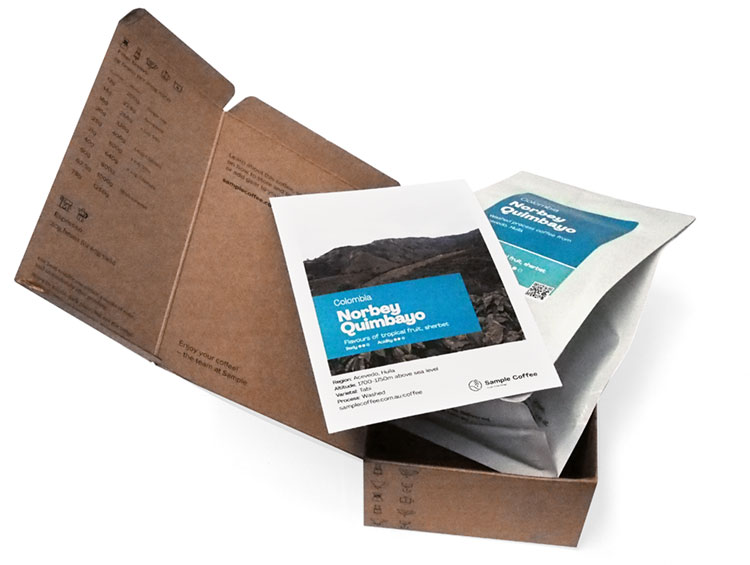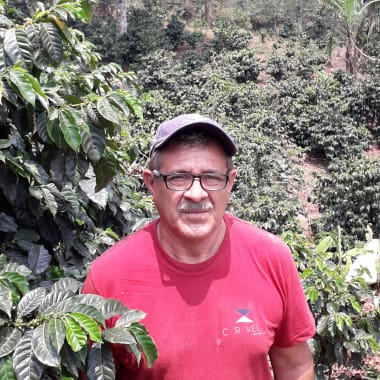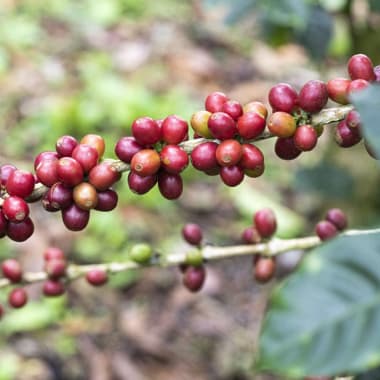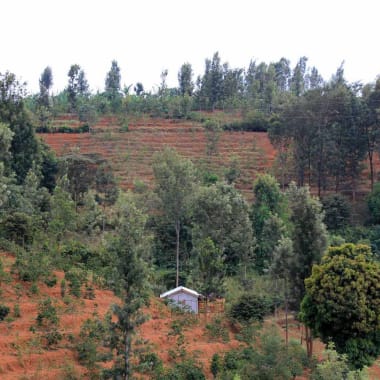-
Producer
-
Rwama Farmers Co Operative Society Ltd
-
Country
- Kenya
-
Region
-
Kirinyaga
-
Altitude
-
1577m above sea level
-
Variety
-
Process
-
Importer
-
Cafe Imports
-
Body
-
Medium
-
Acidity
-
Bright
-
Tasting notes
-
Apple, raspberry, cherry
-
Roast style
Kenya
Muthingini Pb
Muthingini Coffee Factory is located in Kirinyaga District, Njukiini location of Gichugu Division near Kianyaga town. It was established almost 50 years ago and sits on seven acres of land, processing coffee from the farmers of four nearby villages. The Factory is run by Rwama Farmers Co-operative Society, made up of 1,560 local farming families, including 1,000 actively farming.
Muthingini Coffee factory is run by Cyrus Nyamu the factory manager, assisted by seven permanent staff and casual workers.
The area experiences a twice-annual production cycle with an early harvest from April–June, followed by a late second season from October–December.
The main coffee varietal grown is SL28, with around one percent of the crop being Ruiru 11.
Continuing to improve quality
The factory is receiving assistance from our partner Coffee Management Services (CMS) whose long-term goal is to increase quality coffee production in Kenya through farmer training, input access, Good Agricultural Practice seminars, and a sustainable farming handbook updated and distributed annually. They share our goal of transparent, trust based relationships with farmers, helping to support a sustained industry growth in Kenya, bringing premium quality to you brewing coffee at home, and premium prices to the farmers.
Farmers have access to pre-financing for their crops, which is often used to pay school fees and the costs of growing the crop. The factory manager is re-trained every year by CMS, and field days are held for the farmers. Demonstration plots are planted at the factory to reinforce the best practices taught throughout the year.
What is SL28?
This coffee is the SL28 varietal, which is quite common to see on farms in Kenya. It’s been present in our past Brew Crew coffees from Kenya, though it’s not often that it’s been in a harvest without other varietals also being included too.
The SL stands for Scott Labs, who were commissioned in the 1930s by the Kenyan government to survey and catalog all the different varietals that existed in Kenya to find the ones best suited to commercial farming. In particular, the government was looking for a coffee varietal that showed strong resistance to drought and produced a high yield of coffee cherries.
The two strains that were selected were SL-34 and the varietal in this release: SL-28.
The SL-28 didn’t turn out to have particularly high yield, but what it does bring is big, complex delicious flavours.
Serious Eats has more on the story of this varietal.
 Drying tables in Kenya Photo: Silo
Drying tables in Kenya Photo: Silo
Processing at Rwama
After picking, ripe cherry is brought to the factory before it undergoes processing to remove the skin and pulp – known as the wet processing method. Wastewater is discarded in soaking pits, and is also recirculated for conservation. The factory is using a disc pulper with three sets of discs to remove the skin and fruit from the inner parchment layer that is protecting the green coffee bean.
After pulping, the coffee is fermented overnight to break down the sugars, before it is cleaned, soaked and spread out on the raised drying tables, similar to the ones in the photo at the top of this page.
The overhanging pieces you can see hanging from the sides of the tables are used to cover the coffee from extreme sun or occasional rain or damp during drying.
Time on the drying tables depends on climate, ambient temperature and volumes under processing, and can take from 7–15 days in total.
Learn everything about this coffee:
Ethical, traceable sourcing
This page has all the sourcing information (variety, process, region, story, importer, and more) that our importers share with us, and give us permission to use.
The transparency helps us talk confidently about the quality and background of our product, and it helps you know exactly what you’re buying.
Learn more:
Coffee page transparency legend
Our coffee philosophy
Our business approach
Fresh harvest coffee
We only source and roast coffee from each country’s latest harvest season (so the green coffee is never older than 1 year from the time of picking, processing and packing). This ensures the sensory qualities are always at their peak and unaffected by excessive ageing.
Roasted for espresso and filter (best enjoyed black)
Roast style: omni. Omni roasts are designed to brew and taste great both as espresso and filter. Our omni single origins generally sit on Agtron values in the ~70-60 value range. So, technically, they are somewhere in the lighter side of the medium spectrum.
Designed for espresso and filter brewing. Best enjoyed black.
Learn more:
Our Loring Kestrel S35 roaster
Our roasting style and approach
Best brewed within days 15-49 post-roast
The ‘fresh is best’ saying doesn’t apply to coffee (contrary to popular belief). Waiting before opening and brewing your bag of whole coffee beans helps develop peak flavour and acidity.
But heads up: if you buy pre-ground coffee, brew it as soon as possible.
Learn more:
Our recommended brewing window
Try our custom brewing recipes
Our recipes and ratios are tailored to our coffee sourcing and roasting styles, bringing the best flavour and feel out of each coffee.
For pour over, immersion, and other filter brewing styles, check our brew guides.
For our espresso single origins, we recommend a coffee:yield ratio of 1:3:
- Dose: 20g ground coffee
- Yield: 60g espresso
- Total brew time: ~24-28 seconds
This is just a starting point! We encourage you to experiment, taste, and adjust to find the recipe that you enjoy the most.
Learn more:
Our espresso brew guide (single origin)
Brewing ratio calculator
Packaging and sustainability
- Bags: ABA-certified home compostable (AS 5810-2010)
- Labels: recyclable
- Valves (only on +250g bags): general waste
- Box and tape (online orders): recyclable
Learn more:
Our packaging
Variety
SL28 variety
SL28 was developed in 1931 by Scott Laboratories to suit the growing conditions in Kenya. The varietal is known for its exceptional cup quality
The location
Coffee from Kenya
Alongside Ethiopia and Colombia, Kenya is one of the origins we get most excited about at the roastery. It exports some of the most vibrant, bright, and unique coffees in the world.
The Kirinyaga region of Kenya
This region is located east of Nyeri, and has similarly rich volcanic soils and a high percentage of smallholder producers.
Farm processes
Washed process
Machines are used to remove the flesh from the coffee cherry before being fermented in water, washed again, and finally sun dried. This process tends to result in more distinct, cleaner flavours.

Subscribe to a world of coffee
Discover a new single origin coffee from Sample every 1-5 weeks with no delivery fees.
No up-front purchase, and you can pause, cancel, or change plans at any time.
Available to order online this week:

Colombia Carlos Imbachi Pink Bourbon
Flavours of pear, jasmine, sugarcane
Body Acidity
Washed Pink Bourbon
February 2025 harvest
Roasted omni for filter and espresso
Colombia Carlos Imbachi Pink Bourbon online
Nicaragua Mario Ortez
Flavours of lime, cranberry, nougat, guava sorbet
Body Acidity
Washed Caturra
April 2025 harvest
Roasted omni for filter and espresso
Nicaragua Mario Ortez online
Ethiopia Laba Gesha
Flavours of black tea, cherry, prune
Body Acidity
Natural Kurume
February 2025 harvest
Roasted omni for filter and espresso
Ethiopia Laba Gesha online
Colombia La Serrania Decaf
Flavours of blackberry, molasses, milk chocolate (as black) / almond, honeycomb, vanilla (with milk)
Body Acidity
Washed + EA natural decaf Caturra, Castillo, V.Colombia
Roasted omni for filter and espresso
Colombia La Serrania Decaf online